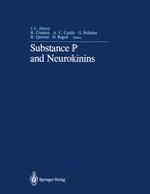1987 | OriginalPaper | Buchkapitel
Tachykinins and Phosphatidyl Inositol Turnover in Rat Brain
verfasst von : T. V. Dam, E. Escher, R. Quirion
Erschienen in: Substance P and Neurokinins
Verlag: Springer New York
Enthalten in: Professional Book Archive
Aktivieren Sie unsere intelligente Suche, um passende Fachinhalte oder Patente zu finden.
Wählen Sie Textabschnitte aus um mit Künstlicher Intelligenz passenden Patente zu finden. powered by
Markieren Sie Textabschnitte, um KI-gestützt weitere passende Inhalte zu finden. powered by
The undecapeptide substance P (SP), a neurotransmitter candidate (1–4), exhibits diverse pharmacological effects in many peripheral tissues as well as in the central nervous system (5). It has been shown that different classes of receptors for a given neurotransmitter are often coupled with distinct second messenger mechanisms to induce their biological effects. In that regard, previous reports have shown that the effects of SP in peripheral tissues (6, 7) and hypothalamus (6) are associated with an increased breakdown of phosphatidyl inositol (PI), suggesting that inositol 1, 4, 5-triphosphate may represent the intracellular second messenger coupled to SP receptors. Mantyh et al. (8) found that the rate of PI hydrolysis was proportional to the number of SP binding sites found in various areas of the rat brain. This suggests that these binding sites correspond to functional SP receptors. It has been shown that different tachykinin receptor sub-types have unique 1igand selectivity patterns and brain distributions (9, 10). However, it is not known if these other classes of tachykinin receptor sites are also coupled to PI turnover. Thus, we have studied the effects of different tachykinins (SP, NKA and NKB) on the PI metabolism in various regions of the brain.
